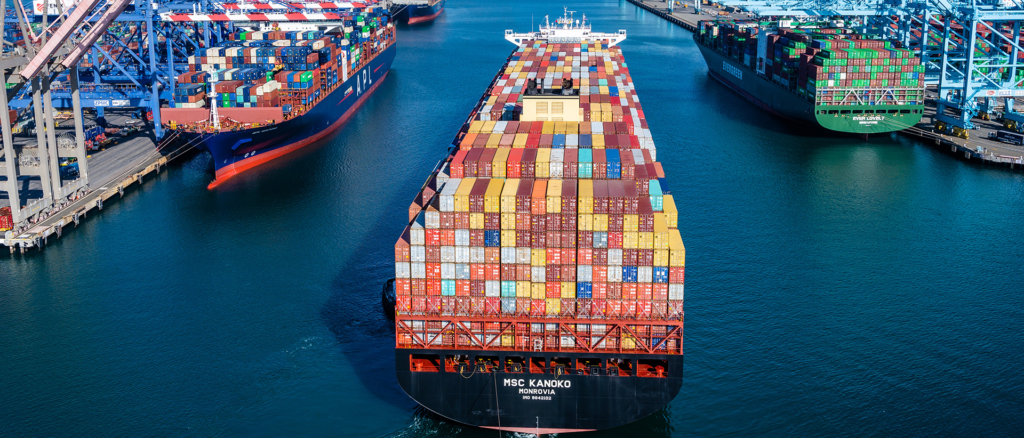Stephen Lyons, the White House’s supply chain envoy involved in the talks between West Coast unions and employers, expressed optimism that a tentative deal is within reach. “The reflections I’m getting from both sides are positive, meaning we should see tentative agreements soon,” Lyons, a retired Army general, said in an email on May 10.
Due to drawn-out contract talks, which began last May, shippers have redirected cargo from West Coast ports to circumvent potential supply chain disruptions caused by labor actions or lockouts. The previous contract expired on July 1, 2022.
Recent disruptions at the Port of Los Angeles and Long Beach have largely stopped. The Pacific Maritime Association (PMA), which represents ocean carriers and terminal operators, and the International Longshore and Warehouse Union’s (ILWU’s) Local 13 chapter, have agreed on manning requirements for cargo handling equipment at certain terminals. An agreement on the use of automated machinery at cargo terminals was reached in April.
Clearing these hurdles has allowed the ILWU and PMA, who are negotiating in San Francisco, to move on to other issues, including wages and pensions.
Once a tentative agreement is reached, the proposed contract will be sent to local chapters for approval by workers. However, it could take a few months for the contract to be finalized, and the business community remains concerned over whether the ILWU membership would conclude a deal, even with a tentative agreement in place.
Source: Transport Topics
U.S. Imports from Asia Uptick in April

U.S. imports from Asia hit a six-month high in April as shippers sped up their cargo on the Eastbound Trans-Pacific, because they were faced with an anticipated round of general rate increases (GRIs) by ocean carriers.
According to PIERS, Asia imports to the U.S. reached 1.35 million TEUs in March. While April imports were down -18.6% compared to a year ago, they grew nearly 25% month-on-month (m/m). Imports from China alone reached 793,604 TEUs, up from 581,479 TEUs in March. Overall container imports to the U.S. in April fell -17.4% year-on-year (y/y) to 2.02 million TEUs but were up from 1.75 million TEUs in March.
Last month, U.S. shippers faced a round of GRIs ranging from $600 to $1,200 per FEU that went into effect on April 15. To support those GRIs, ocean carriers canceled many weekly vessel services from Asia. Sea-Intelligence Maritime Analysis said 502,400 TEUs of capacity, amounting to nearly 20% of ships deployed to both the North American West and East coasts, was blanked during April. The result was that ships saw over 80% utilization in the Trans-Pacific trades, according to data from Linerlytica.
Carriers are still trying to push through rate increases for May and June. Meanwhile, there is little market reaction to the GRIs, according to the Shanghai Containerized Freight Index (SCFI). Ocean carriers have not canceled as many sailings in May as they had in previous months. Sea-Intelligence data shows only 315,500 TEUs of capacity were blanked in May, amounting to just about 12% of deployed ships in the Trans-Pacific.
2023 volumes are not likely to close the gap with 2022 levels until late in the third quarter. The National Retail Federation (NRF) forecasts that May 2023 import volumes will be down -23.5% y/y but projects the y/y but projects the y/y deficit to be significantly reduced by September, with imports for that month expected to be just -3.4% lower than the previous year, according to the NRF.
Source: Journal of Commerce
What to Expect in the Future Five Years of Air Cargo and Freight Forwarding: AfA
Brandon Fried, Executive Director, Airforwarders Association (AfA), shares his thoughts on the current and future air cargo market. He was interviewed by the Air Cargo News Team at the IATA World Cargo Symposium in Istanbul.
As for new vessels on non-mainline trades which include smaller ships, intra-Asia ships, and feeder vessels, the data shows these 11 carriers have a total of 499 newbuildings on order.
“I think cybersecurity is going to be an issue going forward. We’ve seen ransomware attacks prevalent throughout our industry but in a lot of industries as well…”
“You’re going to see capacity improvements..you’re going to have newer aircraft – the a350, more 787s coming online – those are good cargo friendly aircrafts…”
“…you’re going to see tremendous advances in…automated intelligence…it’s going to be interesting to see what types of processes, what types of product develop going forward that make the freight forwarders job easier to handle customer relationships and the rudimentary elements of processing shipments. But we have to remember, we’re never going to take the main element out of the equation and that’s the person, the people, because freight forwarding is all about the creative logistical problem-solving that people provide and that’s what makes us valuable to our customers.”

Source: Air Cargo News
China’s Exports Rebound 14.8% in March, New Container Shipping Routes Added
China’s exports rebounded in March 2023, rising by 14.8% year-over-year (y/y), according to Container xChange’s May Asia container market forecaster. The General Administration of Customs of China also reported that exports in the first quarter of 2023 reached $821.8 billion, a 0.5% increase compared to a year ago.
Chinese ports remain popular trading locations despite the drop in e-commerce globally and geopolitical tension between China and the U.S. China’s major seaports are opening new container shipping routes to expand capacity and increase market share. In Q1 2023, Shandong province launched 13 new shipping routes bound for Europe and the Americas. In addition, ports in Vietnam, Indonesia, and Singapore have also emerged as popular trading locations.
Intra-Asia trade has exhibited resilience, outpacing both the Asia-Europe and Asia-U.S. Despite declining consumer confidence in the EU and North American markets, overstocked retail inventories, and the collapse of ocean freight rates last year, the intra-Asian economy has proven more robust. East Asia was the only region with a positive quarter-to-quarter trade growth rate in the third quarter of 2022, according to the United Nations Conference on Trade and Development (UNCTAD).
China’s trade with the Association of Southeast Asian Nations (ASEAN) has grown substantially, with shipments increasing by 35.4% y/y. The emergence of the China-Southeast Asia trade partnership highlights the economic potential and mutual benefits for both China and ASEAN countries.China’s trade with the Association of Southeast Asian Nations (ASEAN) has seen substantial growth, with shipments increasing by 35.4% y/y. The emergence of the China-Southeast Asia trade partnership highlights the economic potential and mutual benefits for both China and ASEAN countries.
Meanwhile, there continues to be a buildup of empty containers in Chinese ports due to the type of goods being exported from China and their delivery method. Examples include new/alternative energy vehicles, lithium batteries, and solar cells, which are often shipped via specialized vessels known as roll-on/roll-off (roro) carriers rather than standard containers, or bulk cargo such as steel and refined oil is typically transported using dry bulk carriers and tankers.
“The exact reasons behind this phenomenon are complex and involve various factors, including the mismatch between the types of goods exported and container shipping methods used. This paradox highlights the complex challenges faced by the shipping industry and the resilience of China’s international trade,” said Christian Roeloffs, co-founder and CEO of Container xChange.
Source: Hellenic Shipping
China’s Yangshan Port Ranks First in Container Port Performance Index
Yangshan Port in China took the top position in the third edition of the global Container Port Performance Index (CPPI), despite periods of disruption caused by typhoons and other factors in 2022.
Ports in the Middle East and North Africa performed well, with three regional ports finishing in the top five. The Port of Salalah in Oman ranked second, Khalifa Port in Abu Dhabi took third, and Tanger Med ranked fourth.
Ports in Latin America improved performance over 2022, with the Colombian Port of Cartagena taking fifth place overall and Ecuador’s Port of Posorja ranking 19th.
In Southeast Asia, Malaysia’s Port of Tanjung Pelepas rose to sixth place, Vietnam’s Cai Mep secured the 12th spot, and Singapore’s port was ranked 18th.
The Port of Algeciras in Spain is the highest-ranked port in Europe in 16th place.
Wilmington, North Carolina (44th) and the Port of Virginia (52nd) are the top-ranked ports in North America.
The Port of Berbera, ranked 144th, was the highest-ranking port in Sub-Saharan Africa. Many ports in the region continue to experience excessive vessel turnaround time, a persistent risk for supply chain disruption.
Developed by the World Bank and S&P Global Market Intelligence, the CPPI is a data-based comparable index that ranks 348 global container ports according to their efficiency.
Source: splash247.com




